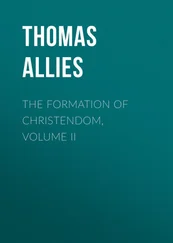Thomas Allies - Church and State as Seen in the Formation of Christendom
Здесь есть возможность читать онлайн «Thomas Allies - Church and State as Seen in the Formation of Christendom» — ознакомительный отрывок электронной книги совершенно бесплатно, а после прочтения отрывка купить полную версию. В некоторых случаях можно слушать аудио, скачать через торрент в формате fb2 и присутствует краткое содержание. ISBN: , Жанр: foreign_antique, foreign_prose, Историческая проза, на английском языке. Описание произведения, (предисловие) а так же отзывы посетителей доступны на портале библиотеки ЛибКат.
- Название:Church and State as Seen in the Formation of Christendom
- Автор:
- Жанр:
- Год:неизвестен
- ISBN:http://www.gutenberg.org/ebooks/38537
- Рейтинг книги:4 / 5. Голосов: 1
-
Избранное:Добавить в избранное
- Отзывы:
-
Ваша оценка:
- 80
- 1
- 2
- 3
- 4
- 5
Church and State as Seen in the Formation of Christendom: краткое содержание, описание и аннотация
Предлагаем к чтению аннотацию, описание, краткое содержание или предисловие (зависит от того, что написал сам автор книги «Church and State as Seen in the Formation of Christendom»). Если вы не нашли необходимую информацию о книге — напишите в комментариях, мы постараемся отыскать её.
Church and State as Seen in the Formation of Christendom — читать онлайн ознакомительный отрывок
Ниже представлен текст книги, разбитый по страницам. Система сохранения места последней прочитанной страницы, позволяет с удобством читать онлайн бесплатно книгу «Church and State as Seen in the Formation of Christendom», без необходимости каждый раз заново искать на чём Вы остановились. Поставьте закладку, и сможете в любой момент перейти на страницу, на которой закончили чтение.
Интервал:
Закладка:
As little could he anticipate another sight, the further fulfilment of the vision, when the provinces, those crumbling toes of the statue, which lay before him in an impending dissolution, were to be formed into great independent kingdoms, having for the common foundation of their power “the Word was made flesh and dwelt among us.” Then in that “connection of ages” which should be drawn out after the time of Augustine in even greater distinctness than before him, and with greater claim upon the believing mind, which “yearns after eternity,” a grander fulfilment of the vision would be disclosed. The royalties set up by barbarian chiefs of tribes among incoherent populations of victors and vanquished were to educate mature nations with individual character in the one Christian faith, and shine as distinct stars set in the crown of the Successor to Peter’s pastorship. For as the Word made flesh created Christian monarchies and Christian nations in their several being, so the charge of the Word to a disciple by the lake of Gennesareth, “Feed My Sheep,” created the great unity of Christendom which bound them together. In Constantine one empire had acknowledged the reign of Christ, and bent the neck of heathen domination to raise the cross upon a heathen crown. But then a group of nations should base the fabric of their laws, and the whole civilisation which redeemed them from barbarism, upon the truth that God assumed flesh for man’s sake, and should acknowledge in Peter’s Successor the Vicar of that God, who by and in that pastoral rule of Peter made them members of one Body, and in so making them “took the Gentiles for His inheritance, and the utmost parts of the earth for His possession.”
This was a second and further fulfilment of the vision, which as yet Augustine saw not, nor even anticipated; but after thus writing he set himself in the last years of his life to a great task, even that of comparing together from their origin to their end the course of the two societies, not national, but world-wide, which run out through human history, intermingled together, and claiming possession of the same man. First, the natural society of the human race played upon by all the passions and infirmities which are the effect of man’s original Fall; and secondly, that other society chosen by God from the beginning in view of His Son’s Incarnation, for the purpose of repairing and counterworking that Fall. It was the capture of Rome by Alaric, and the deep despondency which thence arose in the minds of many, both Christian and heathen, that moved him originally to this design, of which the first tracing is seen in the letter to Volusian just quoted. He sought to meet conclusions unfavourable to the Christian faith, which were drawn by weak, or narrow, or unbelieving minds from the fall of the imperial city. His plan accordingly led him to take a complete view of all human history; and the result has been that one of the last representatives of the old world, and certainly the greatest of all as thinker, philosopher, and theologian, the most universal genius of the patristic ages, whether among Greeks or Latins, has left us a Philosophy of History, the first in time, and as yet unequalled in ability; for it supplies a key to the acts of man and the providence of God in that masterly comparison between the City of God and the City of the devil in their origin, their course, and their end.
The leading thought of this great work gives me a final text bearing on the subject of this volume.
“Thus, then, two Cities have been created by two loves: the earthly, by that love of self which reaches even to the contempt of God; the heavenly, by the love of God which reaches even to the contempt of self. The first has its boast in self; the second in its Lord. For the first seeks its glory from men; whereas to the second, God, the witness of conscience, is the greatest glory. The first in that glory which it has made for itself exalts its own head; the second says to its God, ‘Thou art my glory and the lifter up of my head.’ In the first the lust of domination sways both its rulers and the nations which it subjugates. In the second a mutual service of charity is exercised by rulers who consult the good of subjects, and by subjects who practise obedience to rulers. The first loves in its own potentates its own excellence; the second says to the God of its choice, ‘I will love Thee, O Lord, my strength.’ And thus in the first its own wise men, living after human fashion, pursue the goods of their body or their mind, or both at once, or they who might have known God, have not ‘glorified him as God nor given thanks, but became vain in their thoughts, and their foolish heart was darkened; professing themselves to be wise,’ that is, extolling themselves in their own wisdom through the pride that mastered them, ‘they became fools, and changed the glory of the incorruptible God into the likeness of the image of a corruptible man, and of birds, and of four-footed beasts, and of creeping things;’ for they either led their peoples or followed them in the adoration of such-like images; and ‘worshipped and served the creature rather than the Creator, who is blessed for ever.’ But in the second there is no wisdom of man save piety, by which the true God is rightly worshipped, awaiting its reward in the society of saints, not men only, but angels, that God may be all in all.” 5 5 De Civ. Dei, xvi. 28.
I put together these three facts of human history, the vision of the King of Babylon interpreted by Daniel six hundred years before Christ, the summary of its fulfilment down to his own age written by St Augustine four hundred years after the coming of Christ, and his delineation, a few years later, of the Two Cities, as set forth by him in a work on which the Christian mind has now been nurtured for fourteen hundred and fifty years. The simple juxtaposition of these shows how Babylon stretches to Rome, and Rome is heir of Babylon; and the heathen man thus formed illustrates “the Man who is born in Sion, the city of the great King.” 6 6 Ps. lxxxvi. 5.
It is true that the two great Powers of Civil and Spiritual government, the relation between which forms the subject of this volume, are not exactly represented as concerns that relation in the vision of Daniel; but only the heathen growth of the Civil Power, and the miraculous rise, permanent rule, and progressive growth of the Spiritual Power in the midst of it; yet the mighty promise is recorded that in presence of the Civil Power the Spiritual shall never pass away; rather that it shall last unchanged, while the other is shifting and transitory; and also the cognate truth, that the great and terrible Power represented by the Statue is, in the counsels of God, subordinate in its scope to the Power represented by the Stone.
It is true, again, that the vivid contrast of the Two Cities as drawn by St. Augustine does not represent the legitimate relation of the Two Powers to each other, but only the perversion of the one Power from its true end and object, and the perfect antagonism of the other to that perversion.
But the kingdom set up by the God of heaven in the vision interpreted by Daniel, and the connection of ages dwelt upon by St. Augustine, which leads up to the Person of Christ, and then starts afresh from Him, and the Divine City delineated by St. Augustine, fit exactly into each other, and so they seem to me to form together an appropriate introduction to that most remarkable period of history with which the present volume is occupied, when the Stone cut out without hands struck the Statue, and became a great mountain, in preparation for that further growth when it would fill the whole earth.
The Statue presented in vision to the heathen king has indeed been swept away, but in every country a reduced likeness of it, “the look whereof is terrible,” stands over against “the Man born in Sion.” And the Two Cities everywhere run on in their predestined course until the end contemplated by Augustine takes effect. But as he did not discern the second fulfilment of the divine kingdom which followed upon the wandering of the nations, so neither can we discern the third and yet grander fulfilment when the divine kingdom shall become to the whole world what once it was in the Roman Empire. For, to repeat St. Augustine’s words, “In all these things as we read their prediction, so we discern their fulfilment, and from so vast a portion which is fulfilled we rest assured of what is still to come.” And “the stone that struck the statue became a great mountain, and filled the whole earth.”
Читать дальшеИнтервал:
Закладка:
Похожие книги на «Church and State as Seen in the Formation of Christendom»
Представляем Вашему вниманию похожие книги на «Church and State as Seen in the Formation of Christendom» списком для выбора. Мы отобрали схожую по названию и смыслу литературу в надежде предоставить читателям больше вариантов отыскать новые, интересные, ещё непрочитанные произведения.
Обсуждение, отзывы о книге «Church and State as Seen in the Formation of Christendom» и просто собственные мнения читателей. Оставьте ваши комментарии, напишите, что Вы думаете о произведении, его смысле или главных героях. Укажите что конкретно понравилось, а что нет, и почему Вы так считаете.












